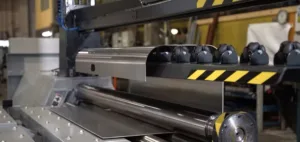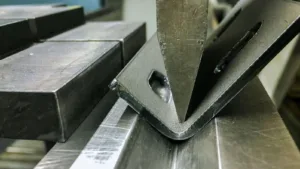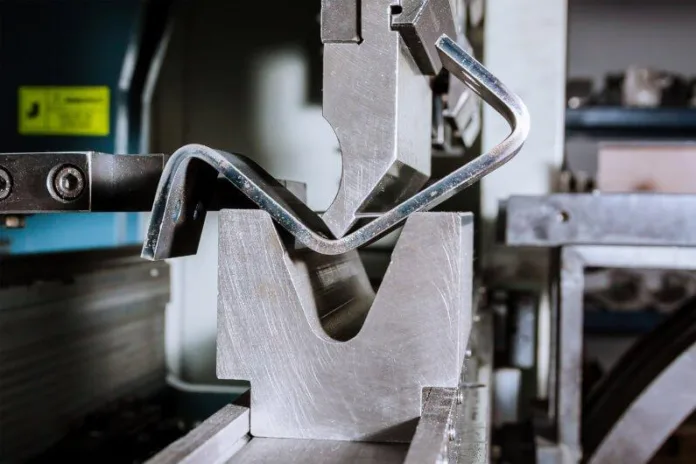Sheet metal bending is one of the effective fabrication techniques product designers utilize to produce reliable and high-quality metal components. This metal forming technique is suitable for low production runs, which might require thin metal to make components when casting fails to provide the desired outcomes.
This article provides an in-depth discussion of everything you need to know about bending sheet metal and a step-wise guide to the process. You will find out the standard sheet metal bending techniques, applications, and helpful considerations for effective sheet metal bending!
Overview of Sheet Metal Bending
Sheet metal bending (also known as edging, forming, flanging, die bending, or press braking) is a standard metal forming process that involves applying a force to a metal sheet with a press brake to create a radius. Manufacturers and product designers often use sheet metal bending techniques to create components like fridges, electronic casings, vehicle body panels, and brackets.
Product engineers bend metal sheets once or multiple times to achieve the final geometry. However, manufacturers often use sheet metal of varying thickness. The minimum thickness of sheet metal suitable for bending is about 127 mm, while the material type and thickness frequently determine the maximum thickness. However, sheet steel is not usually more than 6 mm thick. Hence, the bend radius should be the same or greater than the material’s thickness.
A Stepwise Guide to Bending Sheet Metal

While a press brake is the most commonly used tool for bending sheet metal, it is mechanical and completely manual. Machinists use various CNC (computer numerically controlled) machines with a hydraulic system. Although they have the same working principle, the operator’s interaction differs. We’ll explore steps on how to use a CNC press brake machine to bend sheet metal below:
Step 1: Evaluate the Design Parameters
Ensure you calculate the design parameters such as required force, bend line (the point where the force is applied), and the order of bends (when you need to bend multiple times). Additionally, you have to determine the required die to create the bends.
Step 2: Prepare the Press Brake
Here, you must program the CNC press brake machine with the calculated information, preparing it for the bending operation. As such, the machine understands the required force to exert on the metal sheet to form the right bend and the required order for the bends. In addition, the right tool and die must be attached to the press and brake to make the bend.
Step 3: Align the Workpiece
Ensure the sheet metal is correctly aligned between the tool and die after the machine has been set up. Position the workpiece in the designated area and clamp it tightly to avoid deflection or inaccurate bending. The CNC machine will bend the sheet metal at the bend line once it begins operation.
Step 4: Engage the Press Brake
You have to engage the press brake for it to apply the force parameters programmed into the CNC press brake earlier in the process. Proceed to remove the part once the press brake has bent the sheet metal. Then, prepare for the next stage of production.
Step 5: Inspect and Make Adjustments
Inspect the workpiece carefully for any flaws or necessary adjustments after you have unclamped it. If the bend is inaccurate, you can make minor adjustments with a mallet or hammer. However, you may need to reposition the sheet in the brake and re-bend if the bend angle is slightly off,
Standard Sheet Metal Bending Techniques

Sheet metal bending involves deforming metal sheets along a straight axis using various techniques to achieve varying shapes and bend angles. Here are typical techniques for bending sheet metals to the desired angles:
V-bending
This widely used sheet metal bending technique employs a v-shaped die and a punch in bending sheet metals at preferred angles. The v-shaped punch presses the sheet metal workpiece into the v-shaped groove in the die, forming the metal sheet with different bend angles. For instance, you can make 90°, acute or obtuse angles based on the v-shaped punch and die angle.
U-bending
U-bending is a typical metal sheet bending technique that forms the sheet metal into a U-shape. It involves placing the sheet metal on the U-shaped die that creates two parallel bends with a flat section in between, then using a punch to press it down to force the metal into the U-shaped groove, forming a U-bend. This technique is ideal for making channels and enclosures for different applications.
Air Bending
Like the V-bending, air bending relies on a v-shaped punch and die to bend metals into preferred shapes. However, the punch in the air bending technique leaves space/air below the sheet instead of forcing sheet metal to the cavity’s bottom, allowing more bend angle control.
For instance, you can achieve bend angles ranging between 90° and 180° using the air bending methods if you have a 90° die and punch. Since less springback occurs in this metal bending technique, it provides a more accurate outcome. Springback is often avoided since it can lead to inaccurate bends.
Wipe Bending
This method lets you bend sheet metal into the desired geometry by holding the workpiece against a wipe die with a pressure pad. Then, the punch forces the metal sheet’s edge to extend beyond the die and pressure pad, making it bend over the die’s end.
The wipe bending method provides exceptional mechanical advantages, such as applying less force to achieve the preferred bends and bend angles. Nevertheless, this technique might be unsuitable for making obtuse bend angles because you might need sophisticated machinery capable of producing horizontal force.
Rotary Draw Bending
The rotary draw bending technique involves clamping the sheet metal to a rotary die and drawing around the die to produce a geometry whose radius meets the preferred bend radius. Product engineers typically utilize an internal supporting mandrel in this method to avoid wrinkling on the bent sheet metal’s wall.
The rotary draw bending technique provides extensive benefits compared to other sheet metal bending methods. One of the many benefits of the rotary draw method is that it doesn’t scratch the surface of the sheet metal and can bend metals into sharp corners with obtuse bend angles.
Bottoming
Bottoming bending is a variant of v-bending that mitigates the springback issue by pressing the workpiece down to the bottom of the die, making the workpiece touch the edge of the v- or u-shaped die. It applies additional force through the tip of the punch to deform the sheet metal in the bend region. Also, bottoming is similar to the air bending method because it offers a precise bend angle control.
Roll Bending
In roll bending, you can bend metal sheets into cones, tubes, rolls, and curved shapes. This forming method relies on rollers that feed the metal stock to the desired curvature. The roll bending technique allows you to bend metals into different cross-section profiles comprising various bending curves. It is mainly suited for producing very long sheet metal parts with 0.004 to 0.125 inches range and approximately 20 inches width.
For example, the roll bending machine can create common metal parts used in buildings for roofing, lighting, and HVAC applications such as shelving, panels, and tracks.
Helpful Tips to Consider When Bending Sheet Metal

Even though sheet metal bending types offer desirable outcomes, the process can become complicated if the technique is wrong. Hence, we will discuss helpful tips to ensure you create perfect bends on sheet metals below:
Pick the Right Material
Although different metals are compatible with sheet metal techniques, some are relatively more malleable than others. Hence, it would be best to be mindful of the use of heat and reduce any material cracking and weakening if necessary. Copper, mild steel, galvanized steel, stainless steel, and aluminum are typical materials that work best for sheet metal bends. Copper offers antimicrobial benefits, stainless steel, galvanized steel, and stainless steel exhibit good corrosion resistance and malleability.
Determine Bend Allowance
Bend allowance recompenses what happens to the workpiece when stretched and formed into the desired bend from a flat pattern. Since the metal bending process involves material pushing, pulling, or stretching, you would have to calculate the bend allowance for the sheet metal to derive reliable measurements to work with when you lay out a flat metal sheet. However, when calculating bend allowance, you must consider variables such as internal radius size and material thickness.
Protect the Sheet Metal’s Surface
Preventing the metal’s surface from scratches when bending is essential to attain a fine surface finish. You can use masking tape in any area that comes in contact with something hard. Also, wood blocks effectively protect the appearance of your metal when bending.
Prevent Sharp Internal Corners
When bending metal sheets to desired forms, avoid bending to a sharp internal corner because it can crack or weaken the metal. However, have a radius on your bending tool to mitigate this complication. Additionally, ensure the inside bend radius is the same as the thickness of the material you are bending.
Conclusion
Bending sheet metal is an integral fabrication process with a distinct edge over other manufacturing methods. It offers lower cost, high design flexibility, and increased output, providing functional components and structures for several applications. However, the application’s specific requirements, such as the type of metal, required shape, and production volume, will determine the ideal sheet metal technique for your project. Always work with a professional sheet metal fabricator to get the best results.
